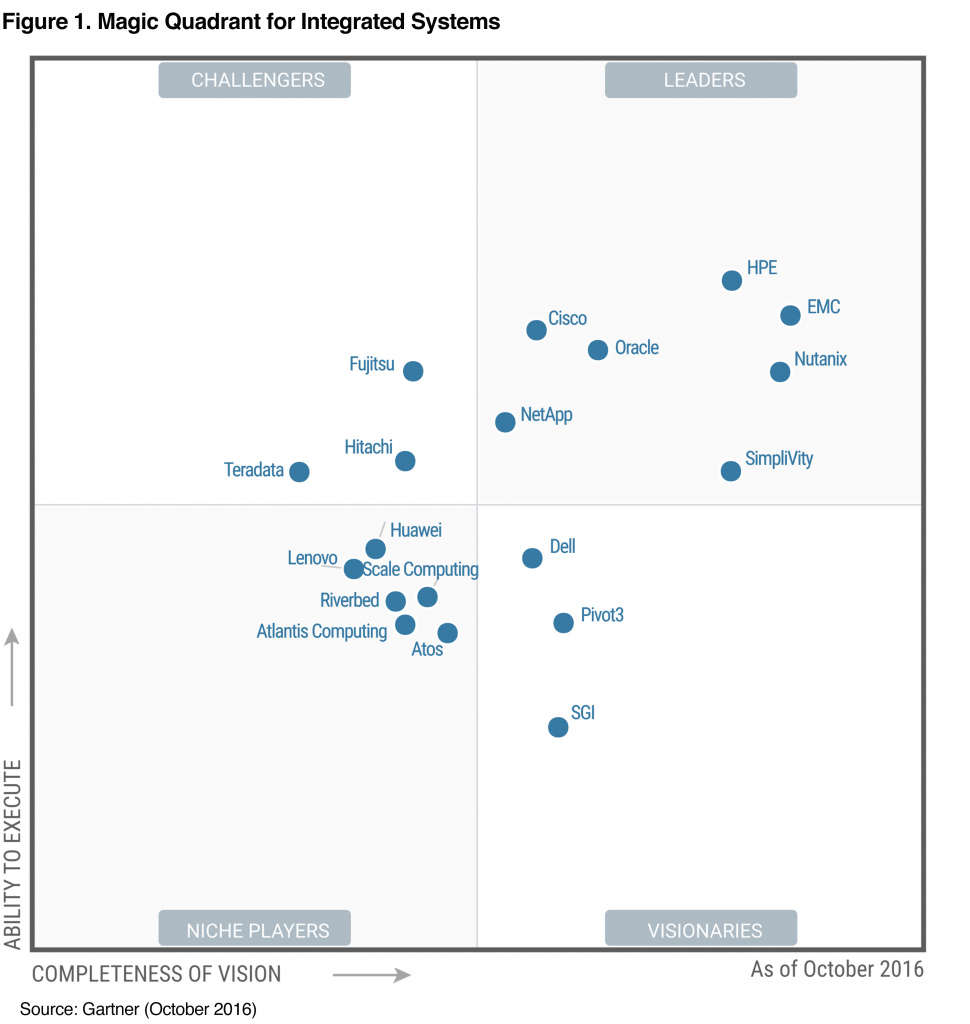Integrated systems based on converged and hyper-converged infrastructure have come a long way in a few short years. There are now instances of these systems spanning everything from appliances designed to be deployed primarily in remote offices with minimal IT intervention to full blown block systems running mission critical workloads in data centers made up of thousands of nodes.
Today, as it did in 2015 and 2014, the Gartner Magic Quadrant report on Integrated Systems clearly positions EMC, now Dell, as a leader in the category because of its combined vision and execution score. We have played a critical role in making it possible to deploy converged (Vblock and VxBlock Systems) and hyper-converged (VxRack Systems and VxRail Appliances) infrastructure throughout the enterprise.
Gartner Magic Quadrant for Integrated Systems:
In fact, the VxRail Appliances family has a strong global footprint. In a period of five months, from its launch in February (GA in March) to August 2016, there have already been 1,700 nodes deployed in more than 70 countries. That translates into 25,000 cores, 400TB RAM and 16PB of storage. Demand in the second quarter of 2016 for our market-leading converged infrastructure portfolio grew 40% year-over-year.
The Dell integrated systems portfolio can address the vast majority of application workloads in any enterprise. Furthermore, when it comes to blade systems integrated with storage area networks (SANs) the Vblock and VxBlock Systems are generally regarded by end users and competitors as the industry benchmark.
“The Gartner report acknowledges the commitment that the Converged Platform and Solutions Division has made over the last decade to researching and developing IT infrastructure innovations that are simple to deploy and manage,” says Chad Sakac, president of the Converged Platform and Solutions Division of Dell. “The better news is that the best is still yet to come as the march towards the software-defined data center (SDDC) continues.”
In addition, Dell improved its position from being in the niche quadrant and into the visionary quadrant. By combining Dell’s integrated systems with EMC’s converged and hyper-converged infrastructures, Dell boasts one of the broadest portfolios of advanced converged and hyper-converged solutions that offers our customers a continuum of choices where they can either build their own outcomes – by individually sourcing compute, networking, storage and software, or buy their outcomes – through highly engineered turnkey solutions.
Many advances have been made across a broad range of approaches to integrated systems. Throughout all those changes we have consistently been a leader in the category. As this market matures many of the integrated systems concepts pioneered are now being implemented across a broad range of products and technologies. As part of Dell Technologies, Dell’s Converged Platforms and Solutions Division is committed more than ever to continue to be at the forefront of driving adoption of converged and hyper-converged infrastructure at every price point.
In fact, Moor Insights and Strategy just issued a report that indicated that EMC and Dell together are positioned to become a converged systems powerhouse. We couldn’t agree more.
This graphic was published by Gartner, Inc. as part of a larger research document and should be evaluated in the context of the entire document. The Gartner document is available upon request from here.
Gartner does not endorse any vendor, product or service depicted in its research publications, and does not advise technology users to select only those vendors with the highest ratings or other designation. Gartner research publications consist of the opinions of Gartner’s research organization and should not be construed as statements of fact. Gartner disclaims all warranties, expressed or implied, with respect to this research, including any warranties of merchantability or fitness for a particular purpose.
